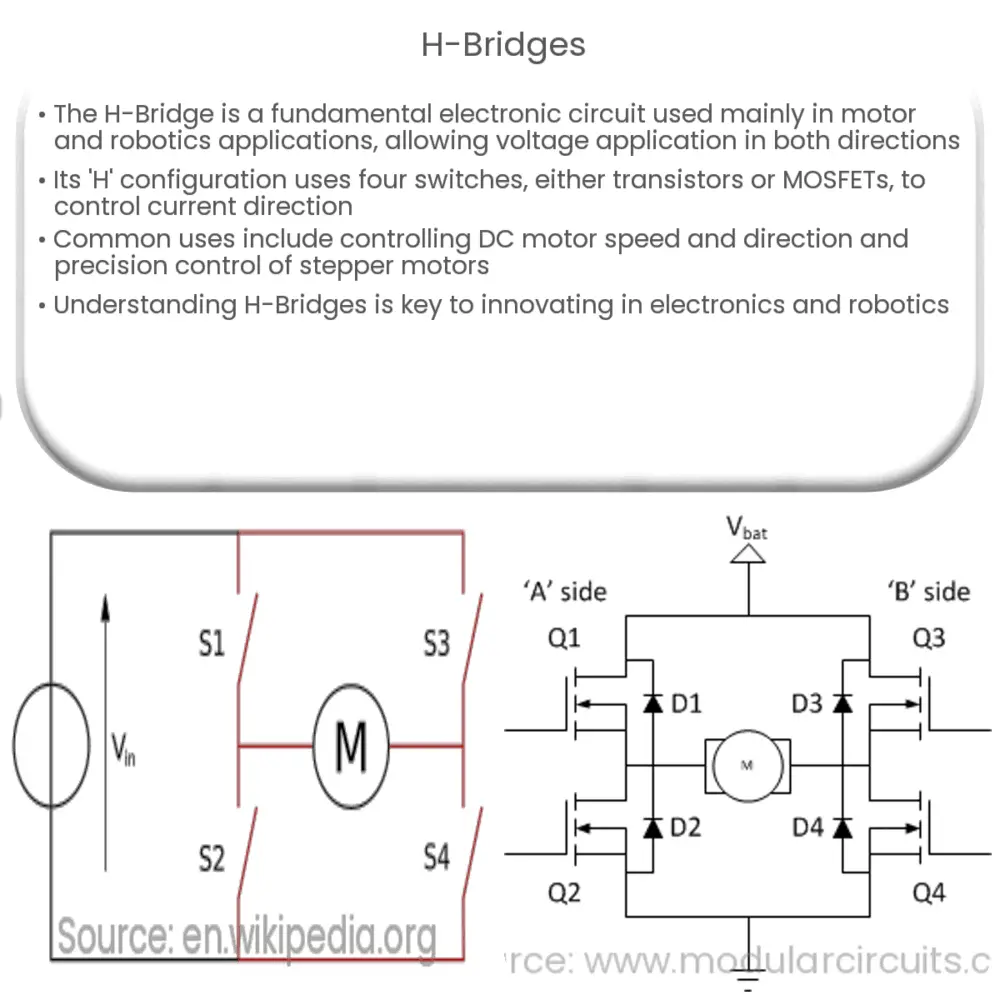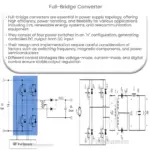Explore the world of H-Bridges in electronics, their working principle, applications, design considerations, real-world designs, and their role in motor control.

Understanding H-Bridges
The term “H-Bridge” may sound mysterious at first, but it’s a fundamental concept in electronics, particularly in the world of motors and robotics. In its simplest form, an H-Bridge is an electronic circuit that enables a voltage to be applied across a load in either direction.
Named for its characteristic ‘H’ configuration, the structure of an H-bridge circuit consists of four switches—these can be either transistors or MOSFETs. The switches are strategically arranged to allow the direction of the current flow through the load to be easily controlled.
Working Principle of H-Bridges
The functionality of the H-Bridge lies in the switches. By controlling which switches are open or closed, we can change the direction of current flow. When the switches on one diagonal (upper left and lower right, or upper right and lower left) are closed, and the other diagonal is open, current will flow in one direction. Reversing which diagonal is closed changes the direction of the current flow.
Applications of H-Bridges
-
DC Motor Control: Perhaps the most common application for H-Bridges is in controlling the speed and direction of DC motors. DC motors are used in a wide range of applications, from toys and household appliances to electric vehicles and industrial equipment.
-
Stepper Motor Control: Stepper motors, commonly used in precision instruments like 3D printers and CNC machines, can be controlled by an H-Bridge circuit. In these applications, the H-Bridge allows for precise control over the motor’s speed and direction.
Without a doubt, the H-Bridge is an essential tool in the field of electronics, and understanding how it works is a vital part of understanding the inner workings of many of our modern devices.
Design Considerations for H-Bridges
There are several key factors that need to be considered when designing an H-Bridge. These include the current rating of the switches, the voltage rating of the switches, and the thermal management of the circuit. Failing to properly consider these factors can lead to circuit failure, or even damage to the device the H-Bridge is supposed to be controlling.
The Role of PWM in H-Bridges
Pulse Width Modulation (PWM) is a method used to control the amount of power delivered to an electronic device. In H-Bridges, PWM is used to regulate the speed of DC and stepper motors. By adjusting the width of the ‘pulse’ of current delivered to the motor, we can precisely control its speed.
Real-World H-Bridge Designs
Most real-world H-Bridge designs include additional features to protect the circuit and increase its efficiency. These may include diodes to prevent back EMF (electromotive force), a phenomenon that can occur when the motor is suddenly stopped, and snubber circuits to protect the switches from voltage spikes.
Integrated H-Bridge Circuits
While it’s possible to build an H-Bridge from individual components, there are numerous integrated circuits available that have H-Bridges already built in. These ICs are compact, easy to use, and include many of the additional features mentioned earlier. Examples include the L293D and the L298N.
Software Control of H-Bridges
In addition to the hardware, the software is also a crucial part of H-Bridge operation. It is responsible for controlling which switches are open or closed, and for implementing the PWM control. Microcontrollers like the Arduino are often used to provide this control, due to their ease of programming and wide range of support.
-
Arduino Libraries: There are several Arduino libraries available that make it easy to control H-Bridges. These libraries provide functions that allow the user to set the motor speed and direction with just a few lines of code.
-
MicroPython: For those who prefer Python, MicroPython also provides libraries to control H-Bridges. MicroPython is a version of Python designed to run on microcontrollers, combining the power of Python with the hardware control capabilities of a microcontroller.
Conclusion
In conclusion, H-Bridges play a crucial role in electronics, particularly in motor control applications. They are versatile, powerful, and, with a bit of understanding, relatively straightforward to use. Whether you’re controlling a small DC motor in a toy or a powerful stepper motor in an industrial machine, the principles remain the same: controlling the flow of current to control the motor’s speed and direction. By understanding and effectively utilizing H-Bridges, we can continue to innovate and advance the field of electronics and robotics.



